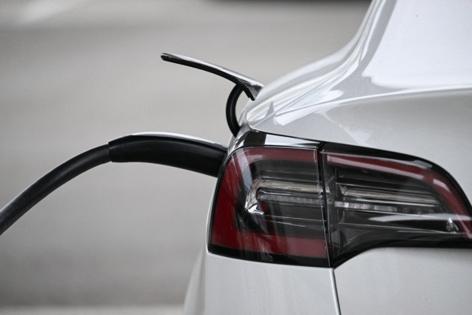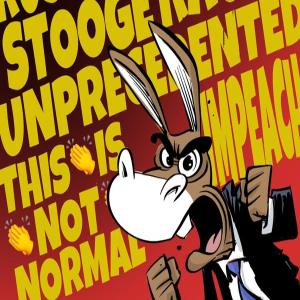Commentary: California can fix Trump's EV mistake
Published in Political News
When he signed his budget bill into law on July 4, President Donald Trump dealt a heavy blow to America’s electric vehicle industry, ending most federal support for U.S. electric vehicle manufacturing and hobbling automakers’ $100 billion effort to catch up with China, the world’s new automotive manufacturing superpower.
Now California alone has the size and market power to fill the void left by Washington’s surrender. Our leaders in Sacramento must step up.
The gutting of EV support never got the national debate it deserved. Americans, including many in Congress, fail to see the real EV issue: China. As the world moves toward a future auto market dominated by electric vehicles — a reality no global auto executive doubts — China has seized the opportunity. It’s China, not the United States, the European Union or Japan, that now rules global automotive manufacturing. For every car, SUV or pickup built in America, China builds about three, and the Chinese have the manufacturing muscle to build five.
Detroit understands this. Along with their European and Asian peers, U.S. automakers have invested tens of billions in North American factories to build the next generation of EVs and compete in global markets. This month at the Aspen Ideas Festival, Ford Chief Executive Jim Farley put it bluntly: “If we lose this (the race for EVs), we do not have a future Ford.”
Unfortunately, the Trump administration is forcing free-world automakers to race against China at a disadvantage. Chinese automakers, awash in government help and subsidies, now manufacture 70% of the world’s EVs. Their advanced, low-priced cars are quickly taking market share in Australia, Europe, Latin America and the Middle East. Mexico is a sobering example. In 2017, 1% of Mexican cars came from China. Last year that number was 20%.
Despite China’s success, have no doubt that U.S., European, South Korean and Japanese automakers can compete. Much of the EV technology that the Chinese have exploited was first developed in the United States. Although China has more than 100 EV brands, only a handful are profitable; many will fade away.
For America and its allies to compete in this race, carmakers must succeed in their anchor American market. (Remember, most foreign car companies — Hyundai, Kia, BMW, Volkswagen and Mercedes — build EVs in the United States, employing thousands of Americans.)
What makes California so important? First, it’s America’s EV leader; over a third of all U.S. EV sales are here; 1 in 4 cars sold in California is electric. Second, California is on the front line of the U.S. auto industry’s research and development battle with China. Lucid developed its world-class power train technology in Orange County. Rivian, in Irvine, licensed its world-class software and electrical architecture to Volkswagen for billions. Tesla has two large factories and several labs here, employing more than 40,000 workers. Ford, the pride of Detroit, has bet the company’s future on a California skunkworks, where hundreds of engineers are working on a new, affordable EV platform designed to compete worldwide.
What can California do to fill the massive void in EV support left by Washington? Plenty. Here are three priorities:
Save consumer credits
Until Sept. 30, buying or leasing a new EV still qualifies for a $7,500 federal credit. When that ends, California should replace it with a $3,500 state credit to lower most lease payments by nearly $100 a month (as any auto salesman knows, consumers make their decisions based more on monthly payments, not total cost.) The $3,500 credit should also apply to used EV sales.
The state has a tangle of consumer EV subsidies; this simple approach should replace them.
To control costs to taxpayers, lawmakers could make these “conquest” credits — that is, they would be limited to first-time EV buyers and leasers. This program should not have income limits. The more new EV drivers the better because data show that most consumers happily stick with EVs once they have leased or bought one. Income limits would simply limit sales volume.
Fix the multifamily charging problem
Many Californians in large metropolitan areas such as L.A. or San Francisco live in apartments or condos without the convenience and cost savings of overnight charging. Instead, they are often forced to wait in line at fast-charging stations, where electricity prices are usually higher than at home. This lack of apartment and condo chargers is a “pinch point” in the EV market that California could take the lead in solving.
Sacramento should agree to fund landlords’ and condo boards’ Level 2 charger installation costs. By my calculations, for the average cost of one six-nozzle fast-charging station, more than 120 multifamily parking spaces could get permanent Level 2 chargers. Tenants would pay for the electricity system maintenance; landlords could charge a modest monthly fee for Level 2-enabled parking spaces.
This would not only spur EV sales among working families but also create thousands of good, union infrastructure jobs. A bonus: Many of California’s full-time ride-hail drivers use EVs and live in apartments. Access to overnight charging where they live would convert their current daytime charging time into earning time and probably reduce their overall energy costs.
Fast-track fast-charging permits
Despite having the most EVs, California is a punch line in the charging industry. Building gas-station–style fast-charging stations here is difficult because of utility company delays and permitting headaches.
As a result, billions of dollars in private capital ready to invest in charging infrastructure has been chased out of California. Of the first wave of fast-charging stations built by Ionna, a well-funded consortium of eight automakers, just one is in California. Sacramento just reformed the California Environmental Quality Act to accelerate home building; it should do the same for EV charging and make building high-speed public “rechargeries” faster and easier.
Gov. Gavin Newsom, a longtime EV driver, and the state Legislature can fill the void left by Washington, championing EV manufacturing jobs and keeping California and the nation competitive in the race to electrify transportation.
____
Mike Murphy is chief executive of the American EV Jobs Alliance and a veteran political strategist based in Los Angeles.
_____
©2025 Los Angeles Times. Visit at latimes.com. Distributed by Tribune Content Agency, LLC.

























































Comments